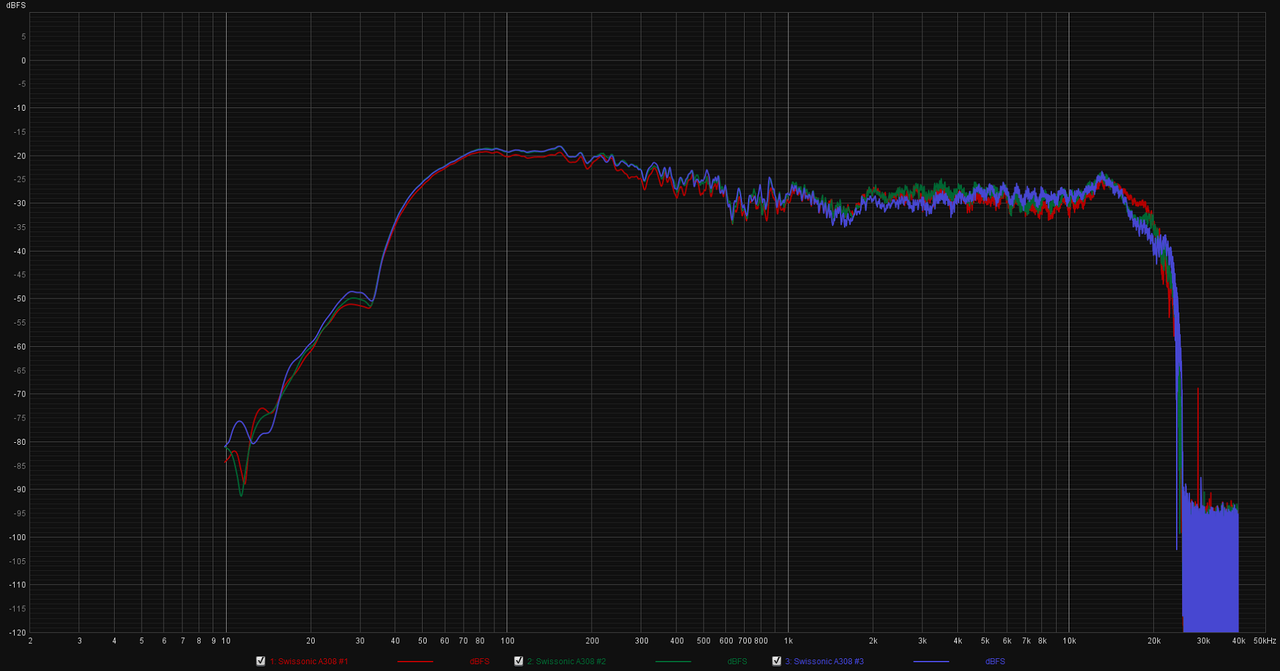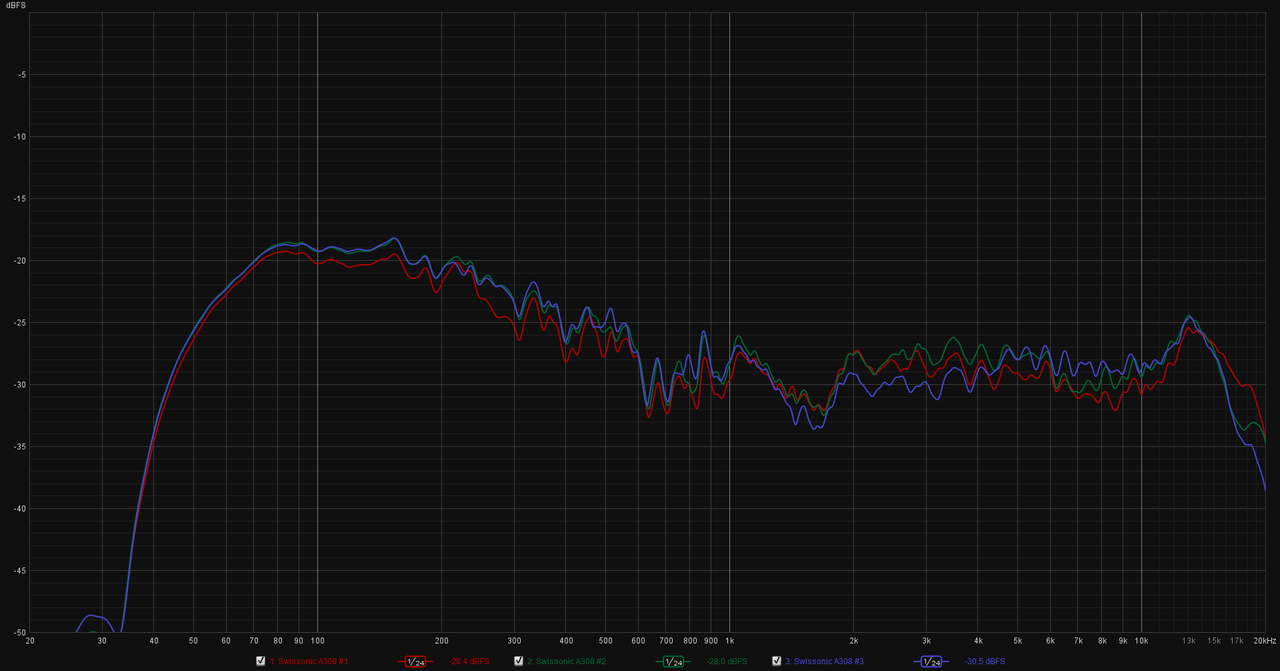Weeb Labs
Addicted to Fun and Learning
Could you possibly post these measurements with a 50dB vertical scale, a 20Hz to 20KHz horizontal scale and 24dB/oct smoothing?took some measurements from 3 different A308 active speakers:

Could you possibly post these measurements with a 50dB vertical scale, a 20Hz to 20KHz horizontal scale and 24dB/oct smoothing?took some measurements from 3 different A308 active speakers:

Thanks for the info! Could you or someone please let me know or direct me to somewhere i could learn how to do this?A-series as well as the X8 use the 1701, but only the A-series can be reprogrammed permanently with SigmaStudio. The three pins to do so are still on the board of the production version. DAC0 and DAC1 are connected to LF as + and -, 2&3 to HF.
You can find detailed documentation for Sigma Studio here and some hardware configuration instructions here. The ideal USBi interface is the TinySine unit.Thanks for the info! Could you or someone please let me know or direct me to somewhere i could learn how to do this?
It looks to me like the A308 has a (DSP) LP filter on the top end about 25Khz, id like to move this further up so I can reproduce 20-40k if needed, like many other speakers can play that range out of the box.

I would like it to run 32bit & 96K-28-/56-bit, 50 MIPS digital audio processor
-Sampling rates of up to 192 kHz are supported
Vertical scale is waaaay too high to observe anything.took some measurements from 3 different A308 active speakers:

He said He doesnt have any plans for the 308. My 306 just came in today though! Had some trouble with them at start though, one wasnt outputting any signal, no matter what I tried. After 5 minutes it suddenly worked. Strange.Vertical scale is waaaay too high to observe anything.
By the way, Erin does have both the 306 and 308 to be reviewed soon. The measurements look great so far.
The ADAU1701 is capable of 1024 instructions per frame at a sample rate of 48KHz. Doubling the sample rate to 96KHz halves the available instructions per frame to 512. This effectively halves the DSP resources available for your program, which may or may not present a problem. In addition to this, you are potentially exposing the amplifier and drivers to ultrasonic schmoo which may introduce IMD and spurious signals that worsen performance in the audible band.the chip can theoretically do it:
I would like it to run 32bit & 96K
The automatic standby is a function of the amplifier rather than the DSP. You would need to identify the amplifier IC and check its datasheet. There is usually a pin that can be pulled high to disable the automatic standby.Ok thanks for the info. Im not aware of any DSP resources needed apart from the crossover, but it seems a bit pointless to mess with the high end.
The standby mode is definitely worth trying to fix, its a mess

 www.audiosciencereview.com
www.audiosciencereview.com
I doubt he has plans for the 308. I sent him the A305, A306 and A203BT.He said He doesnt have any plans for the 308. My 306 just came in today though! Had some trouble with them at start though, one wasnt outputting any signal, no matter what I tried. After 5 minutes it suddenly worked. Strange.
Also i still dont fully understand the sensitivity. Manual says 320mv. Backside says - 10dbv for unbal and +4dbu balanced. But then theres also a switch to change it (for both bal / unbal i dont understand)
Do you use the internal ADC/DAC of the 1701 or separate ones, if I may ask? Great job with the speakersA-series as well as the X8 use the 1701, but only the A-series can be reprogrammed permanently with SigmaStudio. The three pins to do so are still on the board of the production version. DAC0 and DAC1 are connected to LF as + and -, 2&3 to HF.
new spin @pierreSo apparently this woofers sensitivity is increased compared to the sample speaker I used to set up the DSP. I don't like it, but that's what you get when you don't want to pay big dollar for better QC.
Fortunately we added high (2kHz, Q0.35, +-2dB) and low (110Hz, Q0.7, +-2dB) shelf filters to adjust the speaker to ones taste via the dip switches on the back. With the low shelf set to -2dB it is possible to mostly remedy the increased sensitivity of the woofer. The attached measurement is already with this -2dB low shelf filter active. I wish I had set it to +-3dB
Also I have to add another disclaimer: It's really tricky to merge the near- and farfield measurements of a 3-way speaker. The farfield measurement was corrected for groundplane effects and the nearfield measurement of both midrange and woofer was corrected for baffle step. I'd love to see a real anechoic measurement or a nearfield scan extrapolation of the X8, but for now this stitched measurement is the most accurate thing I can provide.
from measurements, V7 looks pretty good, if i have my own peq for room, would you say V7 is as good as A306 or better/worse? or are there some hidden benefits with A-series/X8.. (maybe time alignment?)These are the control measurements from the end of the tuning process. I would love to offer something more precise, but ground-plane measurements are the best I can do in our workshop.
Correct, but. This comment needs to be in context of the size- and price-class."Other than to reduce the high and largely third-tone-dominated distortion in the middle register, of course. Especially about 3% third tone in combination with fifth tone around 250 Hz already at relatively moderate sound pressure levels will be heard clearly."
I agree with you in what you say and I think I-or missed price-performance aspect, which is good.Correct, but. This comment needs to be in context of the size- and price-class.
3% and 10% THD in itself doesn't tell us much, electroacoustic systems are usually incapable of generating high-order distortion in their linear operating range - not enough force.
Due to masking, the generated distortion is quite bening with typical program material. Until it isn't. Then linear range is exceeded.
But the 'linear range' seems to be shockingly high for A306, judging by Erins data. (Measurement error perhaps? Wish manufacturers start to publish AES75 max output levels to compare) Different class than the competing JBL306.
By-the-way, best in class (3 and 10% distortion limited) output award goes to JBL705p/i and Neumann KH150 (data from Sound&Recording).
This one rivals them on output, but is not as clean when driven hard. If excursion is kept at check (>80Hz highpass), then probably Le(i) distortion component keeps it from competing with the best. Proper inductance control costs money (copper cap/shorting ring?)
You could hear the issue on loud passages when A-B comparing with a cleaner trancducer as an added 'grunge', and could be annoying with synthetic test signals (who listens to that??).
So not ideal for SOTA sound production use-cases. But for regular listening? No annoying resonances, correct tonality, no output limiting are vastly more important parameters then couple dB higher low-order distortion. All for EUR100? Maybe the port-resonance could be improved in the future? Anyway kudos @KLang1 !
My only gripe is that there is no A304. Neumann KH80/Genelec 8020 needs some low-cost alternatives.
